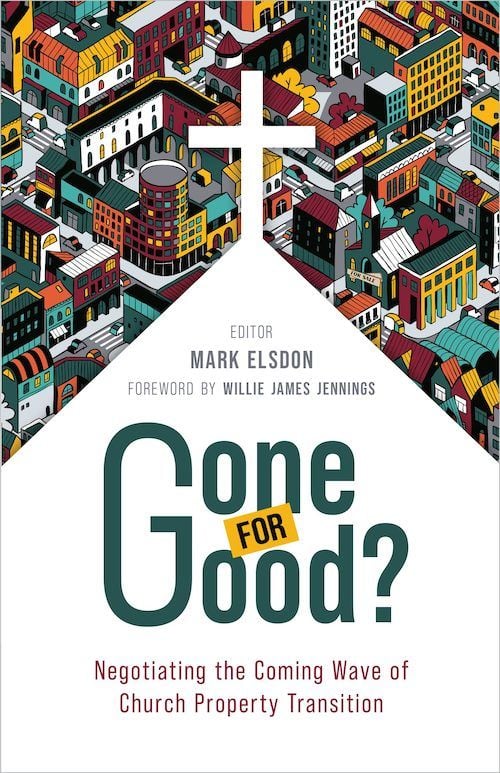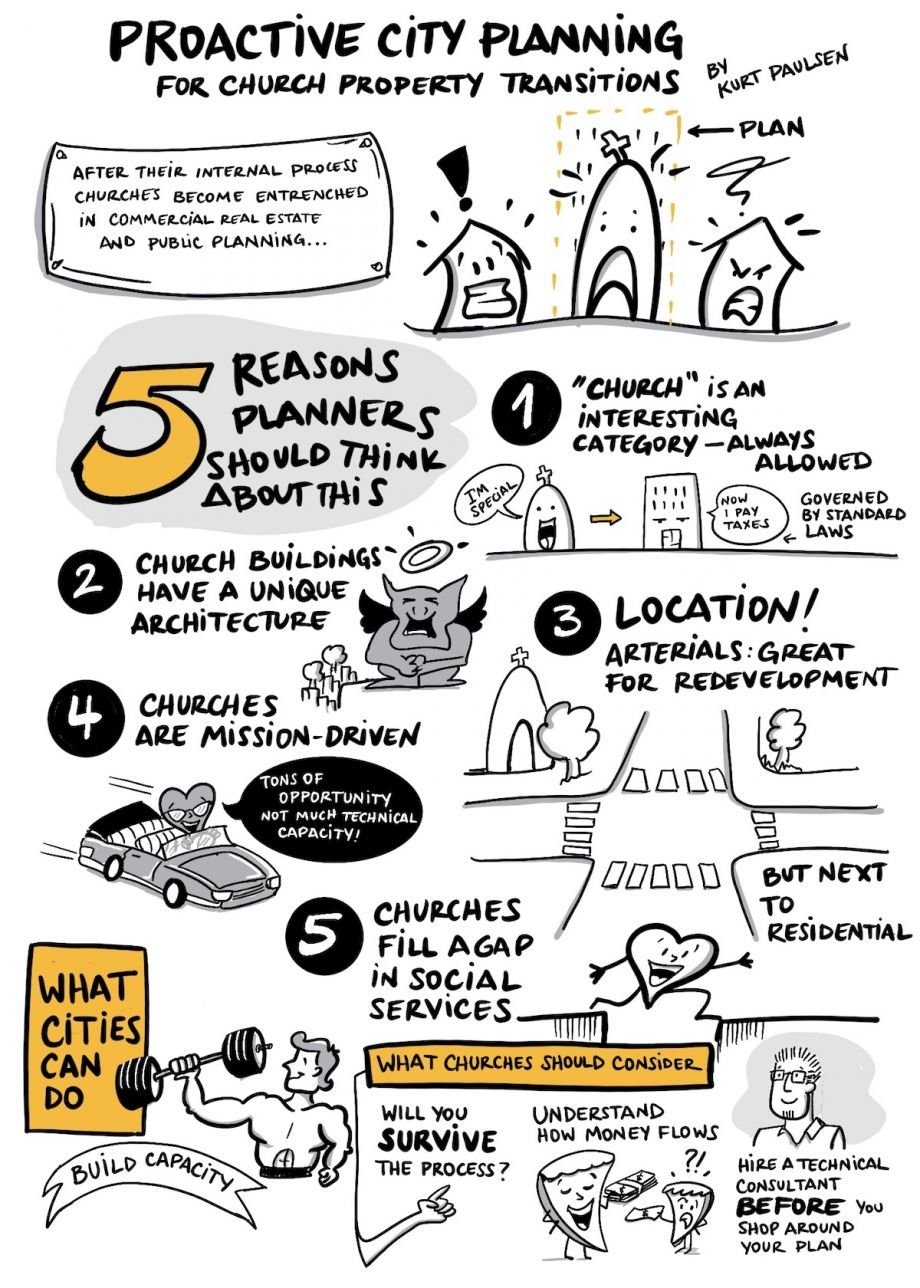Are You A Vanguard? Applications Now Open
Daniel Tseng/Unsplash
This is your first of three free stories this month. Become a free or sustaining member to read unlimited articles, webinars and ebooks.
Become A MemberThe following is adapted from an essay in “Gone for Good? Negotiating the Coming Wave of Church Property Transition” (Eerdmans Publishing, 2024). Edited by Mark Elsdon, the book brings together clergy, property developers, urban planners and more to explore mission-centered transition of church property.
In many religious traditions, one begins with confession, so here’s mine: Though I’m an urban planning professor who researches and teaches urban property and finance issues, I was initially dumbfounded by the concept of the book, “Gone for Good?” Although churches may have been talking about this for years, I suspect most urban planners have not thought much about church property transitions.
In our leading academic journal, the Journal of the American Planning Association, the word “church” (or any variant) does not appear once in the last 10 years. In the main professional publication for planning, Planning Magazine, there are no articles or even brief news items related to church property issues in the past five years.
But church property transitions are happening, whether cities are prepared or not.

Take a recent headline from my local newspaper: “Another Madison Church Hopes to Sell Its Building for Housing Development Project.” The church property is 3.6 acres, strategically located along an arterial road with public transportation, adjacent to an elementary school, near thousands of jobs, and in an ethnically diverse area of the city desperately needing affordable housing. The current building, only 10,000 square feet, dates to the 1960s. The proposal would provide space for the church to continue its worship and provide community services (legal clinics, financial literacy programs, etc.) along with over one hundred affordable housing units.
What’s not to love? A multiethnic church maintains its presence in the neighborhood and better uses its underutilized parcel in a strategic location, and affordable housing for a range of incomes is built where urban planners say it should be—near schools, jobs, and transit. City plans and funding clearly identify the need for more affordable housing, and the city will get the redeveloped parcel back on the tax rolls to fund services and infrastructure in the area. In our expensive city, affordable housing developers have difficulty securing adequately sized and sited parcels for redevelopment at reasonable prices.
This early-stage church property transition likely won’t see occupancy for a number of years. When the church announced its proposal, it was likely the outcome of years of internal conversations, discernment, and strategic planning and an agreement to partner with an experienced affordable housing developer.
But now the public planning process begins. There will be many long neighborhood meetings, plan commission meetings, meetings with city staff, reports, revised site plans and architectural renderings, public hearings, and ultimately a vote at city council.
Urban planners see these property transition proposals all the time. Comprehensive and neighborhood plans show that parcel as “low-medium density residential,” and the current zoning (SR-C1) allows places of worship and single-family detached homes as permitted uses by-right. Because the proposed redevelopment is not consistent with current zoning, the church and the developer will need to go through an “entitlement” process: rezoning the parcel, possible amendment to the comprehensive and neighborhood plans, site plan approval, design review, and all other city approvals such as traffic/parking, lighting, and landscaping.
Every single one of those approvals occurs at a public meeting, some of which may involve a public hearing or public comments. Neighboring property owners will get their say, as will the area’s city council member. In some cities, entitlement processes can be completed in under a year, but in other cities the process can take years and still not be successful. The affordable housing developer also intends to apply for city and county and state funding sources, each with their own separate requirements, meetings, and decision makers.
At every stage, a no vote could kill the project. Without zoning approval, they can’t apply for housing tax credits and city funding, and without funding, the development would not be financially feasible.

(Illustration by Coté Soerens)
For every “successful” case study we observe or imagine — a holistic, inclusive, community development process where cities and neighbors and church property owners work together to create a mutual plan that benefits all stakeholders — we see more cases where the process breaks down or turns acrimonious, where neighboring homeowners thwart needed housing or community services, or where longtime lower-income neighborhood residents feel displaced, powerless, or not listened to by the city or the developer.
The possibility of thousands of church property transitions offers exciting opportunities for “planning world” and “church world” to advance shared values such as providing affordable housing, expanding community services, remedying past injustices, and lifting up the voices of the marginalized and vulnerable. But church property transitions could easily become like most other urban property transitions as sites of conflict or mistrust.
Why are church property transitions a unique category for planners? There are at least five reasons, beginning with the fact that zoning for churches in cities is influenced by a federal law: the Religious Land Use and Institutionalized Persons Act. RLUIPA is designed to protect religious land uses from discrimination in local zoning (and historic preservation) ordinances and prohibits land use ordinances that impose a “substantial burden” on religious exercise or “unreasonable limits” on religious land uses within a jurisdiction. Under RLUIPA, most cities allow churches in residential zones, either as a permitted by-right use or as a conditional use.
But because they’re in residential areas, church property transitions or redevelopment that includes “commercial” land uses – like multifamily housing — can provoke neighborhood resistance. The “church” use of the property with regards to the zoning ordinance is protected by RLUIPA (and possibly state statutes and constitutional provisions), but the proposed “commercial” use might not be. When a property’s proposed new “use” isn’t a “religious use,” the change will be treated as any other private or commercial land-use transition in the public planning process. Federal and state case law on this issue appears to be evolving and unsettled; churches considering property transitions will need experienced legal counsel to navigate potential issues.
In the recent church-to-housing conversion proposal in Madison, the church may believe that the project is a religious exercise, motivated by biblical commands to love, serve, and welcome the marginalized and vulnerable. However, the principal “use” of the property will be the “commercial” use of multifamily residential, which is likely not a protected “religious” land use and will likely be evaluated under the planning and entitlement process the same as any other multifamily building proposal.
A second distinction is that most churches have unique architecture. While not every church is Gothic with stained glass windows, church architecture is often distinct and designed to signal the type of activities that occur in the building. In many neighborhoods, the unique architecture of churches contributes to urban design, sense of place and character of the neighborhood. Even when a church building isn’t protected by historic district regulations, the potential loss of the church architecture may be undesirable for planners and neighborhood residents. Plus, vaulted ceilings, stained glass and large sanctuaries may not be conducive to office or housing use, at least without significant costs. Planners need to consider the trade-offs of preservation with the financial obligations that imposes on aging buildings and the economics of new uses.
Third, churches generally occupy prominent and strategic locations, often along major arterial roads or on significant corner lots. In general, urban planning departments map and identify locational and suitability criteria for areas that are likely to experience redevelopment or are better candidates for redevelopment. Those criteria generally include the parcel size, proximity to higher capacity transportation facilities, and the location of the parcel relative to established neighborhoods. There’s substantial overlap between property features that are suitable for redevelopment and the location of many church properties. Cities should consider updating or revising their redevelopment strategies and policies to potentially include current church properties.
Fourth, a church property transition is a unique process compared to commercial or profit-oriented transitions. Congregations are likely unfamiliar with the public planning process and therefore may need attention and support from the city to accomplish their mission-driven goals. Both planners and churches are (or should be) committed to social justice and inclusive community processes. The opportunity to work with willing property owners committed to these values means a real opportunity to advance city goals. The trade-off is that congregations may not have the experience and technical capacity of experienced for-profit development teams, and so may need additional support and technical assistance.
Fifth, the incumbent church property already provides a wide range of community services and social capital infrastructure that would potentially be lost if the property is simply redeveloped and the church moves. As part of a neighborhood planning process, cities might consider what services are currently provided by churches (and other nonprofits that might use church facilities) and prepare for the impacts if churches no longer exist in some areas of the city. All nonprofits (including churches) need revenue to maintain their level of programming and services. Cities should consider that some form of income-producing property may be necessary to maintain churches in neighborhoods with the capacity to continue service provision. If not, the quality of life in the neighborhood may decline, which could require the city and taxpayers to provide more services.
First, a city should consider convening a forum or work group of interested religious groups (or nonprofits generally) that might be considering property transitions. Working with and through established church associations, this group could share best practices, provide information and education, and strategize together. Such a forum could be a reasonably low-cost way (in terms of staff time) for staff to reach out and learn about potential redevelopment projects.
Second, a city planning department could consider a dedicated process team or staff team to provide technical assistance to churches that are considering property transitions. The idea is that by creating a way for property owners to meet with and work with staff as early in the process as possible, staff can provide guidance on the process and recommend steps to engage with neighbors and other stakeholders.
Third, planners should consider evaluating and updating their neighborhood plans or redevelopment plans to consider which church properties are potentially going to experience a property transition in the coming years. This proactive planning can make the process transparent and can ensure that the city’s priorities, policies, and funding are aligned.
As the New York Times recently highlighted, houses of worship across the nation are redeveloping their land and property to address community development needs including affordable housing. In the YIGBY movement, local governments and churches have shown they can work together to change zoning rules and facilitate affordable housing on church properties, a win-win for cities and faith communities.
In the coming decade, tens of thousands of church properties are likely to change hands. It’s time for planners and local governments to awaken to the positive possibilities of helping to manage these church property transitions — and what could be lost if proactive planning is not undertaken.
Kurt Paulsen is a professor of urban planning in the Department of Planning and Landscape Architecture at UW-Madison. He’s a contributor to the book “Gone for Good? Negotiating the Coming Wave of Church Property Transition” (Eerdmans Publishing, 2024).

20th Anniversary Solutions of the Year magazine